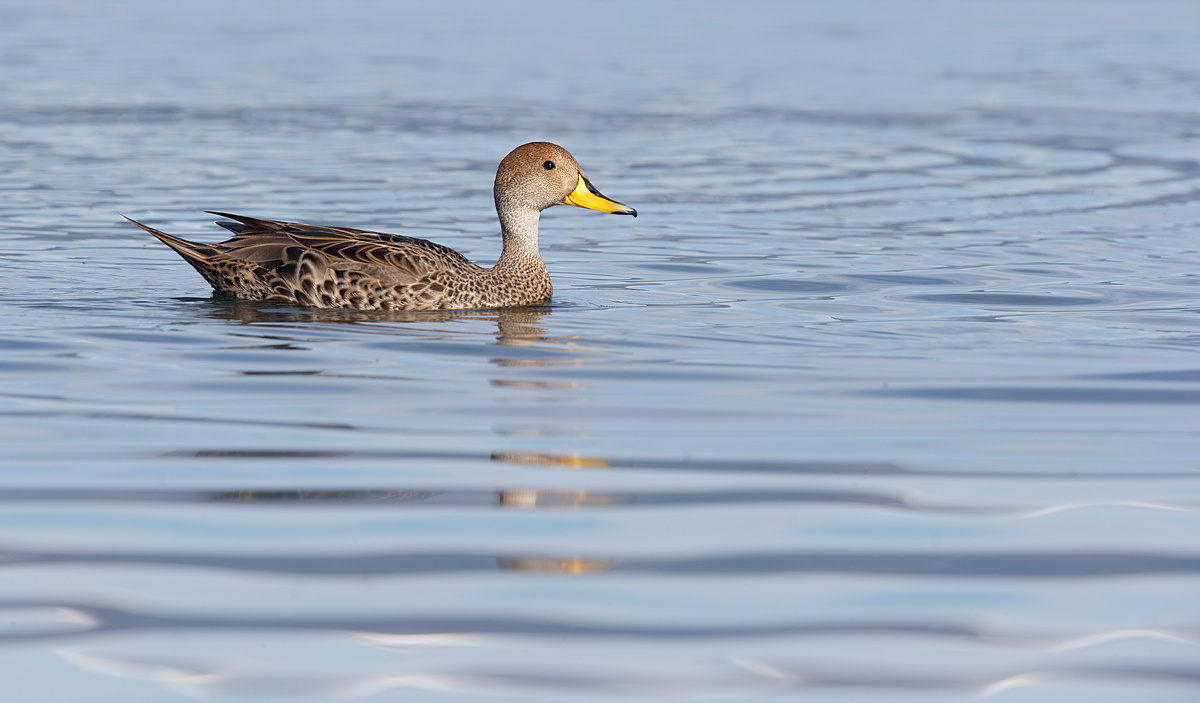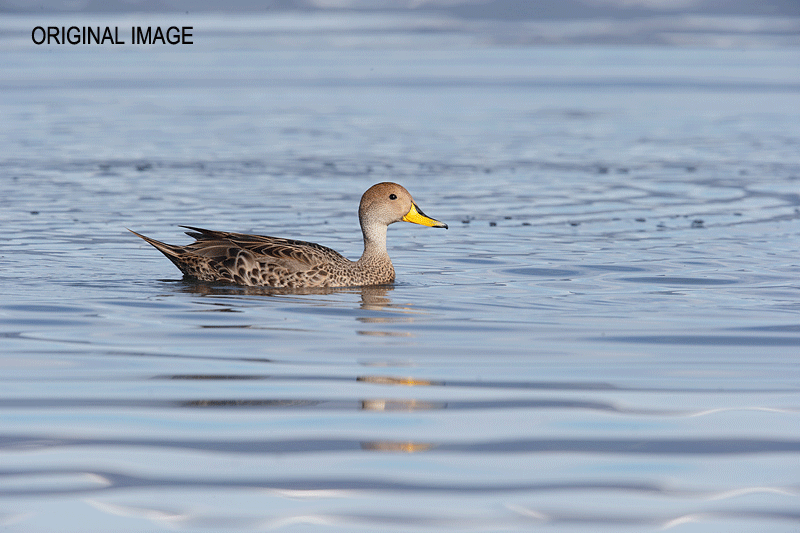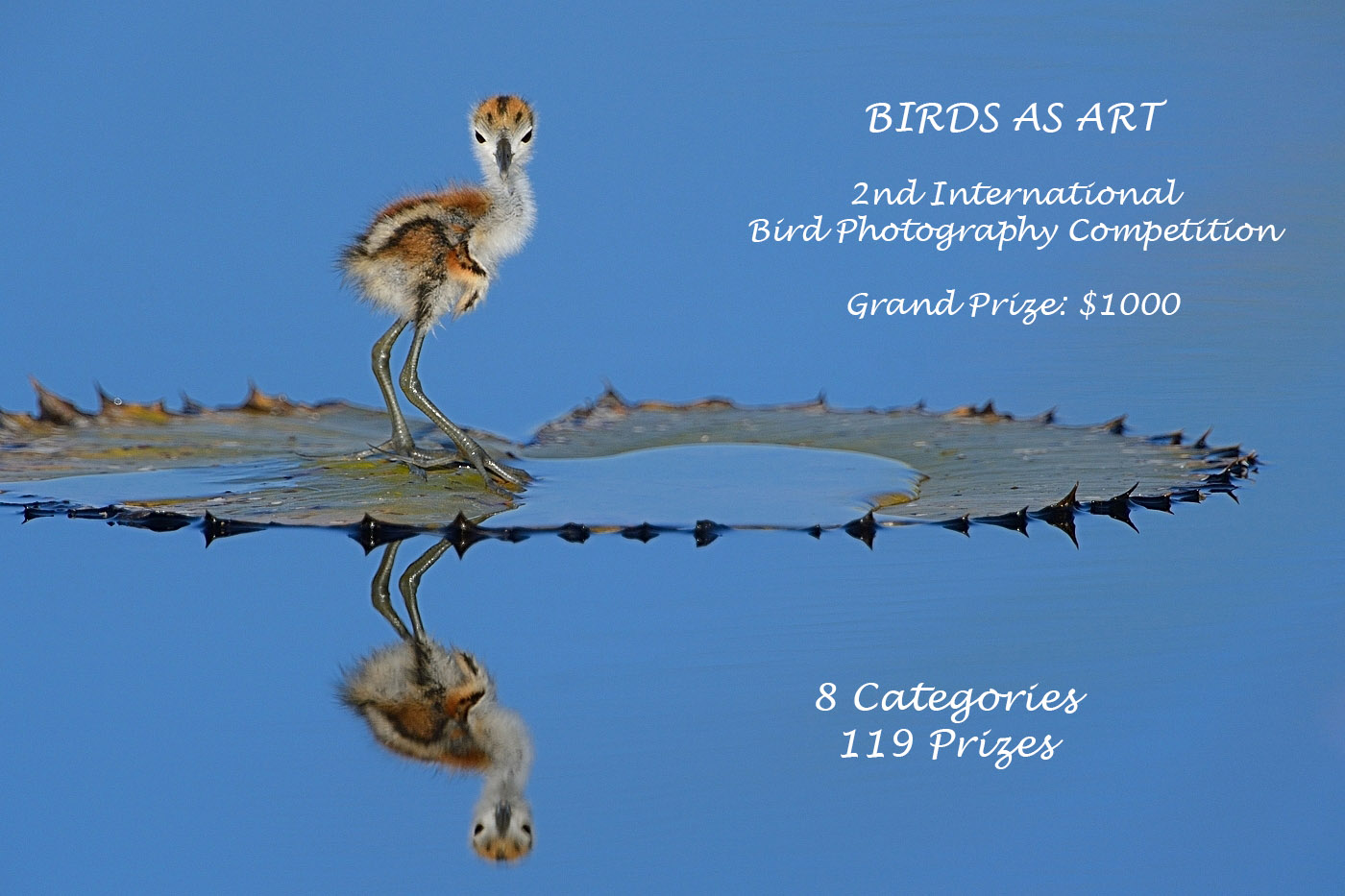
|
|
The original for this optimized Yellow-billed Pintail image was created with the Gitzo 3532 LS carbon fiber tripod, the Mongoose M3.6 head, the Canon EF 600mm f/4L IS II USM lens, the Canon 2x EF Extender III (Teleconverter), and the Canon EOS-1D X. ISO 400. Evaluative metering +1/3 stop: 1/640 sec. at f/11 in Manual mode. Central sensor (by necessity) Expand/AI Servo Rear Focus AF on the upper breast just above the waterline active at the moment of exposure. Click here to see the latest version of the Rear Focus Tutorial. Click on the image to see a larger version. |
“Editing Practice/Yellow-billed Pintail: Keep One or Both?” Update and Reasoning
In the November 9, 2013 blog post (Editing Practice/Yellow-billed Pintail) here, folks were asked, “keep One or both?”
At first glance I was sure that the answer was Image B for the reasons given by multiple IPT veteran Alan Lillich (along with lovely wife Pat) who wrote in part, I would keep the second one. The bird’s pose and sharpness is the same in both. The second has a little more room above the head to the dark line of water. It also has more room to the first dark dot in front of the bird, more comfortable cloning space for me. I would crop it into a pano. Cut off the left just in front of the leftmost dark dot that the tail points to. Cut off the bottom just above the higher bit of reflection showing some yellow. Cut off the top just below the upper dark water, keeping the lowest semi-dark line and some lighter above it. Take nothing off the right, I like the circular waves.
But, however, a funny thing happened on the way to the Phorum. (Note: Phorum is not a typo :)).
After taking a close look at the two images, I realized that I liked the taller head and the elongated neck better in Image A as suggested by Ken Kovak who swam against the tide when he wrote (again in part), I am going to go against the trend of what is posted so far and select the first image. What decided for me is in the first(number 2894)image the duck’s neck is slightly more elongated and pleasing to me.

|
The Image Optimization
To create the optimized image that opens this blog post I went with image A and used the Patch Tool and the Clone Stamp Tool at 40% hardness to eliminate all the cruddy brown spots. You can check out the clean-up work and the crop in the animated GIF above. Be sure to give it a few moments to play.
Though Alan Lillich’s suggested crop would have worked well, I decided to place the bird near the upper left third because I really liked the white swirlies along the lower frame edge. The crop therefore, was from the left and the top.
All of my clean-up tools and techniques are described in detail in our in Digital Basics File, an instructional PDF that is sent via e-mail. It includes my complete digital workflow, dozens of great Photoshop tips, several different ways to expand canvas, all of my time-saving Keyboard Shortcuts, Quick Masking, Layer Masking, and NIK Color Efex Pro basics, and tons more.
Insane Deal on One of My Very Favorite Lenses
This amazing offers expires soon!
Right now B&H is offering one of my very favorite lenses, the Canon EF 70-200mm f/2.8L IS II USM lens, at the ridiculously low price of only $1899.00 The regular price is $2499.00. They are offering a limited quantity as follows: after clicking on one of the BAA affiliate links here proceed to checkout to receive the $2199.00 price. Follow that up with the mail-in-rebate $300.00. When the smoke clears you will own this great lens for only $1899. The rebate is good only for US purchasers. The $1899 is the lowest ever price anywhere. Get one today and earn a free contest entry.
Note: the rebate is good only for US purchasers. If you missed this blog post, ” Scenic, Wildlife, & B-roll Versatility,” click here. It featured a variety of images created at Torres del Paine with my 70-200 II,
I have this lens with me on every trip. I use it as above for scenics and habitat images. I use it to create bird scapes and images of groups of birds, for flight images of single birds with either TC and often with the 1.4X III TC for flocks in flight and for blast off blurs. It is a great travel and all purpose nature and wildlife lens. It is rare that I am in the field without having the 70-200 II on my shoulder via the Black Rapid S-7 strap.
…..
Bosque IPTs/Late Registration Discounts Increased!
For information on both the 7-Day and the recently announced short version of the 2013 Bosque IPTs please scroll down here. If you would like to join us for the first 3 or 4 days of this IPT please shoot me an e-mail. Please call Jim at 863-692-0906 or e-mail for late registration discount info.

|
BIRDS AS ART 2nd International Bird Photography Competition
Learn more and enter the BIRDS AS ART 2nd International Bird Photography Competition here. Twenty-five great prizes including the $1000 Grand Prize and intense competition. Bring your best.
2014 Tanzania Summer Safari
If you are interested in joining us in Tanzania next summer please shoot me an e-mail and I will be glad to forward you the PDF with dates, itinerary, and price.
Support the BAA Blog. Support the BAA Bulletins: Shop B&H here!
We want and need to keep providing you with the latest free information, photography and Photoshop lessons, and all manner of related information. Show your appreciation by making your purchases immediately after clicking on any of our B&H or Amazon Affiliate links in this blog post. Remember, B&H ain’t just photography!




Amazon
Everyone buys something from Amazon, be it a big lens or deodorant. Support the blog by starting your search by starting your search by clicking on the logo-link below. No purchase is too small to be appreciated; they all add up. Why make it a habit? Because I make it a habit of bringing you new images and information on an almost daily basis.
Typos
In all blog posts and Bulletins feel free to e-mail or leave a comment regarding any typos, wrong words, misspellings, omissions, or grammatical errors. Just be right. 🙂
IPT Info
Many of our great trips are filling up. You will learn more about how to make great images on a BAA IPT than anywhere else on the planet. Click here for the schedule and additional info.













